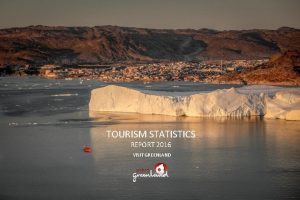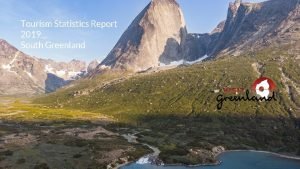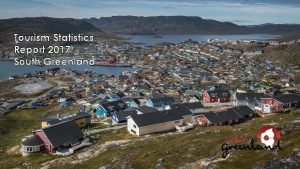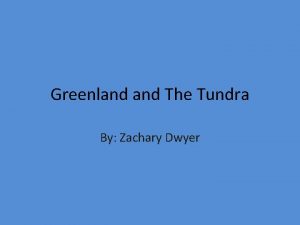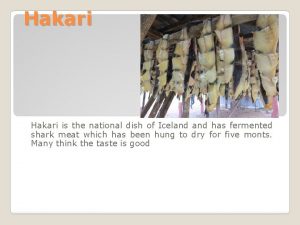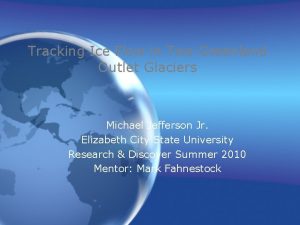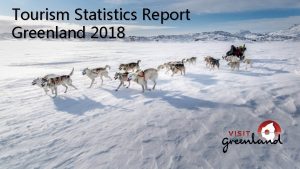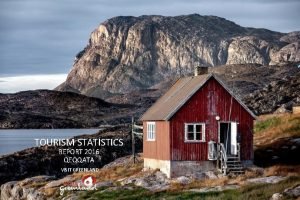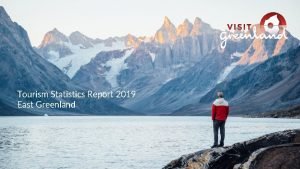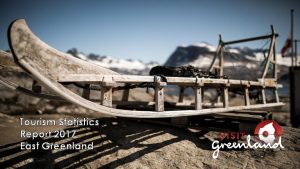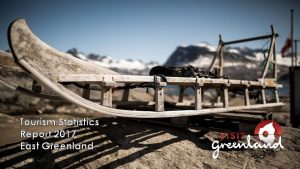Tourism Statistics Report 2018 South Greenland Introduction This









- Slides: 9

Tourism Statistics Report 2018 South Greenland

Introduction This year the regional reports have been delayed, because it did not make sense to publish them without the 2018 cruise statistics that were not published until the 27 th of August 2019 on stat. gl. Statistics Greenland was waiting for some overdue port call registration submissions. It is highly recommendable to read this short region specific report in addition to the national report, as it deals with far more aspects of the tourism statistics and does so, on a better statistical foundation. As one can observe on the next few pages there is a difference between the number of international flight passengers travelling out of Narsarsuaq (3. 330 in 2018) and the number of international guests in the accommodations in South Greenland (5. 332 in 2018), which is primarily due to a share of the tourists in the region arriving via Nuuk and are thus not registered in Narsarsuaq. A few may also have arrived by different boat types than cruise ships (where the tourists rarely buy overnight stays ashore), but is likely very few. It is of course a challenge for the region that there are no direct flights via Iceland Copenhagen outside of the summer high season, which means that the tourists have to travel via Nuuk, making the journey longer and significantly more susceptible to delays. The recently approved airport package includes a new 1. 500 meter regional airport in Qaqortoq with a connection to Iceland, which according to Kalaallit Airports is supposed to be ready by October 2023. This, of course, will provide completely new conditions for the tourism industry in South Greenland, as the capital Qaqortoq and most cities and villages in the region will become more accessible. However, villages such as Narsarsuaq, Qassiarsuk and Igaliko will become a little less accessible than with the current placement of the airport. As Narsarsuaq will carry on as a heliport, and the boat connection to Qaqortoq and Narsaq continues, the trip in the helicopter will likely serve as “added value ” for tourists that can afford this luxury. But also the slightly less expensive boat trip to Narsarsuaq Fjord can be marketed as a great experience on its own, and not necessarily to the disadvantage of tourist operators working in the area around Narsarsuaq. Thus, the tourism industry will be in a transitional period over the next 3 -4 years, where new products and package trips must be prepared, and it will be exciting to see how new products and projects come to life. As always, Visit Greenland is happy to help explore these new opportunities. The new UNESCO South Greenland World Heritage site faces an exciting future where the region will continue to work to improve and develop the destination management including the new visitor centre which is on the drawing board in cooperation with the Ministry of Industry, Energy and Research.

Flight Passengers Travelling Out of Greenland Via Narsarsuaq Airport With 95. 3% of all passengers on international departures travelling out of Narsarsuaq registered by country of residence the data for 2018 is statistically valid, whereas the 2017 data with 87. 9% registered is not. This is reinforced by the fact that all segments, except from DK, make up samples of less than 1. 000 passengers, which means that a difference of only a few passengers from year to year can cause large percentage differences. The growth of 2. 0% for tourist segments combined must thus be taken with appropriate reservation. It should also be noted that tourists also arrive in the region via the Nuuk-Narsarsuaq route, which we at present unfortunately do not have concrete numbers on. The total number of international passengers travelling out of Narsarsuaq incl. Passengers residing in Greenland are completely registered both years, and here we can observe with -0. 2%, which indicates that the tourism development may have been close to the status quo. On the following page we can compare it with the development in the overnight stays numbers in the region. Even though the growth percentages are not statistically valid, we can focus on numbers on 2018, which are 95. 3% complete in relation to the number of international departures directly out of Narsarsuaq. Here one can see that Denmark and Spain continue to be the two largest segments, and it looks a though there have not been any significant changes compared with 2017. If the 2017 numbers are congruent with reality, Iceland saw a growth of 98 passengers, the equivalent of a staggering 135% growth (which illustrates our point that growth percentages can quickly become distorted in relation to small samples). The Germany segment observed an increase of 38 passengers, the equivalent of a 19. 4% growth. The remaining segments are such small samples that it does not make any sense to highlight growth percentages in comparison with 2017.

Number of Overnight Stays in the Region In March 2019 Visit Greenland counted the bed capacity in Greenland, and it shows that registrations are submitted for 80. 4% of the CVR registered bed capacity in South Greenland. The reader should note that an unknown number of tourists have spent the night under open sky or in private homes, thus data and growth percentages in this graph must be taken with appropriate reservations. The trend from the flight passenger data can be observed here as well, there is a decline in relation to the Denmark segment (here -6. 1%), the equivalent of 285 fewer DK overnight stays. The Other Europe segment had 133 more overnight stays, the equivalent of a growth of 6. 1%. The Germany segment had 25 more overnight stays, the equivalent of a growth of 3. 3%. The Other Countries segment had a staggering 545 fewer overnight stays, the equivalent of a decline of -47. 3%. The France segment had 116 more overnight stays, the equivalent of a growth of 24. 4%. The Iceland segment had 101 fewer overnight stays, the equivalent of a decline of -17. 3%. The USA segment had 125 more overnight stays, the equivalent of a growth of 38. 4%. A total decline in the tourist segment of -5. 0% is obviously not positive, but it can also be due to more or less natural fluctuations from year to year. In relation to the first half of 2019 on a national level a fairly good growth can be observed, but from experience we know that the first and second quarters combined only represent approximately 1/3 of the total amount of tourists in a year, so it is too early to draw any meaningful conclusions. More than half of the tourists usually visit the country during the third quarter.

Number of Individual Guests in the Region There is a surprisingly large difference in the growth in the number of international guest (10. 4%, see the graph below) compared to the -5. 0% decrease in the number of international overnight stays. If this corresponds with reality, it means that even though there were 504 more international guests in the accommodations in South Greenland than in 2017, on average they bought fewer nights per guest than the year before. Thus the average for international guests in 2018 was 2. 0 nights per tourist vs. 2. 3 in 2017. While it is not a drastic difference, the growth difference between 2018 and 2017 looks significant, which is primarily due to small samples that statistically can cause some disproportionate percentage fluctuation as mentioned on page 3. There is a good growth in the Denmark segment with 288 more guests, representing a 17. 8% increase. The Other Europe segment: A growth of 176 more guests/15. 0%. The Germany segment: A growth of 37 guests/8. 9%. The France segment: A growth of 83 guests/35. 1%. The Other Countries segment: A decline of 210 guests/-41. 4%. The Iceland segment: A growth of 20 guests/8. 1%. The USA segment: A growth of 68 guests/37. 9%. The Italy segment: A growth of 44 guests/46. 5%. The Great Britain segment: A growth of 40 guests/44. 5%. The remaining segments each represent less than 100 guests. Unfortunately, we do not have data on how many of the tourists spend the night elsewhere than in accommodations that submit registrations, but there have likely been a lot of hikers that camp under open sky as well as people that have visited friends – especially from the DK segment.

Occupancy Rate in Accommodations in the Region As is the case in most of the other regions, the season development over the 12 months of the year is the shape of a pointed hat, with the majority of the activity from June through September. The graph to the left shows the development in occupancy rate in South Greenland. It shows that even during high season there is plenty of available capacity. In that graph guests residing in Greenland are included. The graph to the right only shows the number of overnight stays for international guests. This confirms the common knowledge that there are not many tourists in Kujallaq outside of the summer season. However, the months of January-February 2018 were slightly more positive than the same months in 2017. South Greenland faces a challenge in creating demand during the off-season. The industry needs a more even season development in order to create more year-round jobs. The future airport in Qaqortoq will make the southern capital quite a bit more accessible, especially if flights from/via Ice land are more evenly distributed over the year.

Cruise Tourism – Number of Guests 2008 -2018 On the 27 th of august 2019 Statistics Greenland published the 2018 cruise statistics. Publication was delayed due to some overdue submissions of port call registrations. On the same date revised figures for 2017 were published on bank. stat. gl/tudkrp. The new number (see the graph to the left) shows a significant increase in the number of passengers in 2017 and 2018, the equivalent of a 57. 5% growth from 2016 to 2017 and a 19. 8% growth from 2017 to 2018 nationally. Numbers on 2015 and 2016 are currently still being revised and can be expected to be adjusted upwards. The graph to the right shows the number of cruise passenger in 2017 and 2018, where a combined increase of 8. 7% can be observed. In Qaqortoq alone there was an increase of 17. 6%, and in Nanortalik of 29. 4%. Narsaq and Narsarsuaq saw a decrease of -80. 2% and -20. 9% respectively, while the level for Qassiarsuk was practically unchanged. Experience shows some variation from year to year in relation to the timetables of the cruise lines and which ships sail Greenland, so a part of that development must be attributed to natural variations in the market, more so than demand for the individual region. 7

Cruise Tourism – Number of Port Calls According to Capacity 2017 -2018 The graph below shows the number of port calls in South Greenland in 2017 and 2018 by the 4 so called “pax classes” – i. e. according to the passenger capacity of the ships. There were 65 port calls in the region in both 2017 and 2018. The main cause of this increase in the total number of passengers is the size of the ships that call on South Greenland, and here one can observe that there has been 5 more port calls by the very large ships with room for more than 1. 200 passengers. There were 8 less port calls by ships in the 1 -250 pax class, 4 more port calls in the 251 -500 pax class and one port call less in the 501 -1. 200 pax class. It has been crucial to the development that the large ships such as AIDAvita (1. 266 pax), Oriana (1. 880 pax), Serenade of the Seas (2. 490 pax) and Sea Princess (1. 950 pax) visited South Greenland for the first time in 2018. Before the 1 st of January 2016 port fees were charged at 525 DKK per passenger regardless of how many port calls the ship had in Greenland. From the 1 st of January 2016 they are charged at 1. 1 DKK multiplied by the gross tonnage of the ship. This means that a ship such as Serenade of the Seas with its 90. 090 gross tons and 2. 490 pax in 2018 would have to pay (1. 1 x 90. 090) 99. 099 DKK for its one port call in Qaqortoq, while in 2015 it would have had to pay (525 x 2. 490) more than 1. 3 million DKK if it was at full capacity. It is a huge saving, so the strategy of changing the port fees in order to attract more and bigger ships seems to be working according to plan. The bigger the passenger capacity the bigger the saving compared with the former fee model, so that is probably one of the reasons why we see the biggest increase in relation to the largest ships.

Final Thoughts The flight passenger numbers are indicative of a small growth in tourism in 2018, while in relation to overnight stay numbers one can observe both positive and negative indications. South Greenland is, along with Sermersooq East the two numerically smallest tourist regions as far as the land-based tourism is concerned. As mentioned, this has the statistical effect that growth percentages are easily boosted even at relatively small changes in the number of tourists in the different segments, so growth percentages for 2018 must be taken with reservations. Furthermore there an unknown number of tourists that do not feature in either the flight passenger statistics or in the overnight stay statistics. Overall, indications of land-based tourism are likely to be taken as an expression of a modest positive development. Cruise development is more unambiguous, with an increase of 8. 7% for South Greenland as a whole. Based on the port calls announced for 2019, growth also looks set to continue this year. It is relevant to consider how to ensure sustainable development in cruise tourism, as it is a fact that especially the largest ships each emit CO 2 equivalent to thousands of cars. It may also be relevant to increase cooperation with the cruise lines in relation to landings to ensure that both tourists and locals overall receive a positive benefit. In the autumn of 2019 Visit Greenland carries out a questionnaire survey among the Greenlandic population about their experience of tourism in their daily lives and their attitudes towards future development. Ultimately, it is a fine balance between business development and sustainability. The region enters a new exciting phase in the tourism development, both because of the new opportunities afforded by the UNESCO site, but also because of the opportunities the future airport in Qaqortoq will bring. In addition, a regional destination company has been established again in recent years, whose mission is to strengthen the region’s tourism development, marketing and brand. It is the expectation of Visit Greenland that all of these initiatives and opportunities will lead to a positive development for the tourism in the region. We look forward to a continued fruitful cooperation! Best regards Visit Greenland Compiled by Mads Lumholt, Visit Greenland, September 2019
